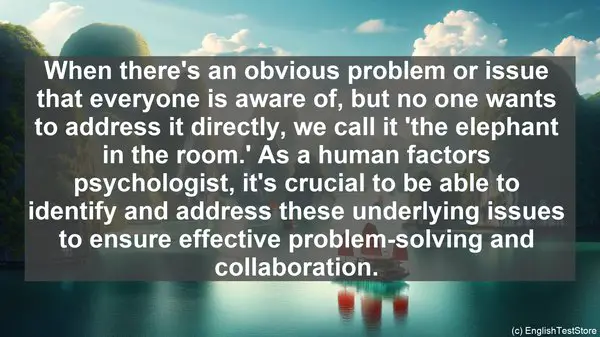1. The Elephant in the Room
When there’s an obvious problem or issue that everyone is aware of, but no one wants to address it directly, we call it ‘the elephant in the room.’ As a human factors psychologist, it’s crucial to be able to identify and address these underlying issues to ensure effective problem-solving and collaboration.
2. The Tip of the Iceberg
This idiom refers to a situation where what is visible or known is just a small part of a larger, more complex issue. In human factors, it’s often the case that the surface-level problem is just the tip of the iceberg, and there are deeper underlying factors that need to be considered for a comprehensive solution.
3. The Devil’s Advocate
Being the ‘devil’s advocate’ means taking a contrary or skeptical position in a discussion or debate. In human factors, this role is crucial as it helps to challenge assumptions, uncover potential risks, and ensure a thorough evaluation of different perspectives before making decisions.
4. The Domino Effect
The ‘domino effect’ refers to a chain reaction where one event or action leads to a series of similar events. In human factors, understanding the potential cascading effects of a design decision or a system failure is essential to prevent or mitigate larger-scale consequences.
5. The 800-Pound Gorilla
When there’s a significant, powerful, or dominant force that everyone is aware of, but no one wants to confront, we refer to it as the ‘800-pound gorilla.’ In the context of human factors, this could be a dominant player in the industry, a challenging constraint, or a critical issue that needs to be addressed.
6. The Silver Bullet
The ‘silver bullet’ is a metaphor for a simple, magical solution that can solve a complex problem. However, in human factors, we often encounter complex, multi-faceted challenges that require a holistic approach rather than relying on a single ‘silver bullet.’
7. The Red Herring
A ‘red herring’ is something that distracts attention from the real issue or problem. In human factors, it’s essential to identify and avoid these distractions to stay focused on the core objectives and challenges at hand.

8. The Catch-22
The ‘catch-22’ is a situation where you’re trapped in a dilemma or a paradoxical condition with no easy way out. In human factors, we often encounter complex trade-offs and constraints that can create these ‘catch-22’ scenarios, requiring careful analysis and creative problem-solving.
9. The Whole Nine Yards
When we say ‘the whole nine yards,’ we mean going all the way or doing everything possible. In human factors, this could refer to conducting a comprehensive user study, considering all relevant factors in a design, or implementing a thorough evaluation process.
10. The Ball is in Your Court
This idiom is often used to indicate that it’s someone’s responsibility or turn to take action or make a decision. In human factors, effective collaboration and communication often involve clear indications of when the ‘ball’ is in someone’s ‘court’ to ensure smooth workflow and accountability.

